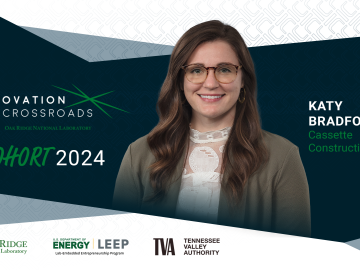
Filter News
Area of Research
- Advanced Manufacturing (2)
- Biological Systems (1)
- Biology and Environment (42)
- Clean Energy (48)
- Computational Biology (1)
- Computational Engineering (1)
- Computer Science (5)
- Fusion and Fission (5)
- Isotopes (24)
- Materials (35)
- Materials for Computing (7)
- National Security (30)
- Neutron Science (23)
- Nuclear Science and Technology (6)
- Quantum information Science (2)
- Supercomputing (95)
News Type
News Topics
- (-) Artificial Intelligence (85)
- (-) Biomedical (49)
- (-) Buildings (43)
- (-) Clean Water (18)
- (-) Computer Science (154)
- (-) Isotopes (50)
- (-) Machine Learning (38)
- 3-D Printing/Advanced Manufacturing (92)
- Advanced Reactors (19)
- Big Data (41)
- Bioenergy (75)
- Biology (83)
- Biotechnology (21)
- Chemical Sciences (61)
- Climate Change (79)
- Composites (20)
- Coronavirus (35)
- Critical Materials (17)
- Cybersecurity (31)
- Decarbonization (71)
- Education (5)
- Element Discovery (1)
- Emergency (2)
- Energy Storage (79)
- Environment (148)
- Exascale Computing (40)
- Fossil Energy (5)
- Frontier (42)
- Fusion (48)
- Grid (43)
- High-Performance Computing (79)
- Hydropower (5)
- ITER (4)
- Materials (105)
- Materials Science (109)
- Mathematics (8)
- Mercury (9)
- Microelectronics (4)
- Microscopy (39)
- Molten Salt (4)
- Nanotechnology (46)
- National Security (68)
- Net Zero (11)
- Neutron Science (106)
- Nuclear Energy (88)
- Partnerships (50)
- Physics (60)
- Polymers (23)
- Quantum Computing (32)
- Quantum Science (60)
- Renewable Energy (2)
- Security (24)
- Simulation (43)
- Software (1)
- Space Exploration (15)
- Statistics (2)
- Summit (53)
- Sustainable Energy (81)
- Transformational Challenge Reactor (7)
- Transportation (57)
Media Contacts

Daryl Yang is coupling his science and engineering expertise to devise new ways to measure significant changes going on in the Arctic, a region that’s warming nearly four times faster than other parts of the planet. The remote sensing technologies and modeling tools he develops and leverages for the Next-Generation Ecosystem Experiments in the Arctic project, or NGEE Arctic, help improve models of the ecosystem to better inform decision-making as the landscape changes.

Katy Bradford is on a mission to revolutionize the construction industry and is the founder of Cassette Construction, a company in the newest cohort of Innovation Crossroads, a DOE Lab-Embedded Entrepreneurship Program node at ORNL. As an Innovation Crossroads fellow, Bradford and her company will receive technical, financial and networking support to successfully advance the company’s products to the marketplace.
After retiring from Y-12, Scott Abston joined the Isotope Science and Engineering Directorate to support isotope production and work with his former manager. He now leads a team maintaining critical equipment for medical and space applications. Abston finds fulfillment in mentoring his team and is pleased with his decision to continue working.

As high-tech companies ramp up construction of massive data centers to meet the business boom in artificial intelligence, one component is becoming an increasingly rare commodity: electricity. Since its formation in 2004, the OLCF has fielded five generations of world-class supercomputing systems that have produced a nearly 2,000 times reduction in energy usage per floating point operation per second, or flops. With decades of experience in making HPC more energy efficient, the OLCF may serve as a resource for best “bang for the buck” practices in a suddenly burgeoning industry.

A team led by scientists at ORNL identified and demonstrated a method to process a plant-based material called nanocellulose that reduced energy needs by a whopping 21%, using simulations on the lab’s supercomputers and follow-on analysis.

Office of Science to announce a new research and development opportunity led by ORNL to advance technologies and drive new capabilities for future supercomputers. This industry research program worth $23 million, called New Frontiers, will initiate partnerships with multiple companies to accelerate the R&D of critical technologies with renewed emphasis on energy efficiency for the next generation of post-exascale computing in the 2029 and beyond time frame.

As a mechanical engineer in building envelope materials research at ORNL, Bryan Maldonado sees opportunities to apply his scientific expertise virtually everywhere he goes, from coast to coast. As an expert in understanding how complex systems operate, he’s using machine learning methods to control the process and ultimately optimize performance.

Flexcon Global has exclusively licensed two patented inventions to manufacture a self-healing barrier film from ORNL for research and development purposes. The film can be incorporated into vacuum insulation panels to increase the efficiency of buildings during retrofits. Under a cooperative research and development agreement that began in 2021, Flexcon and ORNL have been exploring the capabilities of the technology and fine-tuning its properties.

A research scientist with the Department of Energy’s Oak Ridge National Laboratory, Ayana Ghosh was named the 2024 Early Discovery Award winner by the American Ceramic Society. The award recognizes an early career member of the organization who has contributed to basic science in the field of glass and ceramics.

Nuclear physicists at the Department of Energy’s Oak Ridge National Laboratory recently used Frontier, the world’s most powerful supercomputer, to calculate the magnetic properties of calcium-48’s atomic nucleus.


